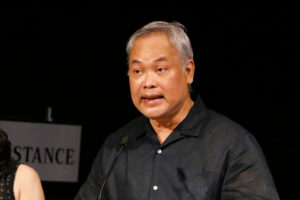Making art that matters

Chris Millado at the ‘Damay
At Dangal’ event
last Apr. 9.
LIKE towns all around the country, Victorias, Negros Occidental held regular town fiestas. So, it comes as no surprise that while growing up there in the 1970s, the young Chris B. Millado developed a fascination with carnivals or the local perya.
“I was very much exposed as a kid to town fiestas,” Mr. Millado told BusinessWorld in an interview via Zoom.
“One of the centerpieces of the town fiesta is the carnival where you have different activities going on,” he said. These included parades, marching bands, games and competitions, and enjoying the food.
“It was a multi-sensory event which stuck with me, and I thought those were the experiences in my youth that drew me to certain cultural experiences…,” Mr. Millado said of what would later inspire one of his proud achievements as the artistic director at the Cultural Center of the Philippines (CCP).
FROM PEOPLE POWER TO MARCOS REDUXMr. Millado graduated with a Bachelor of Arts in Theater at the University of the Philippines-Diliman in the early 1980s. While in college, he founded his own theater companies that presented political theater. He joined the CCP after the People Power revolution in 1986 which toppled the dictator, Ferdinand E. Marcos, Sr.
“When I joined the CCP, it was 1986 which was right after People Power revolution and the CCP then was going through a substantial or profound reorientation in terms of democratizing the accessibility to the space, decentralizing the leadership, Filipinizing the content,” Mr. Millado said.
The CCP, after all, had been the pet project of the first lady Imelda Romualdez Marcos whose ideas of “the good, the true, and the beautiful” were reflected in the projects and productions of the CCP.
The reorientation was done under the leadership of then CCP vice-president and artistic director Nicanor Tiongson.
Mr. Millado worked under the CCP Outreach program for just a short while before going on to pursue masteral studies in New York in 1989. He returned to the CCP in 1993, working under the Performing Arts Department before leaving again, this time for a teaching stint abroad. Upon returning in 2000, Mr. Millado became artistic director for Tanghalang Pilipino, one of the CCP’s resident companies. He became CCP’s associate artistic director in 2003, and eventually took on the role of vice-president and artistic director in 2011.
“It did not occur to me at all that in the future, the artistic directorship was going to be part of my life,” Mr. Millado said.
“What was very clear to me was that I wanted to be a theater artist. I want to be a theater director. So, one of the images of the CCP that stuck with me was the Artist’s Entrance… [It] became like some kind of special portal for me,” he said.
Mr. Millado retires this month, just as Ferdinand Marcos’ son, Ferdinand “Bongbong” Marcos, Jr., is to be sworn in as President of the Philippines. There are already questions swirling in cultural circles about how the CCP might refocus now with the restoration of the Marcos family.
HIGHs AND LOWS AS ARTISTIC DIRECTORAs he anticipates retirement this month, Mr. Millado recalls significant events during his 11 years of service as CCP’s vice-president and artistic director.
Upon assuming the role in 2011, his main goal was to make art matter to everyone. “One of the first things that I looked into was how to make the CCP [come] alive with events now,” he said.
Mr. Millado also aimed at initiating more art festivals to draw audiences in.
“Festivals have a good way of bringing a lot of audiences because of its multi-arts multi-activity platform,” he said. “It is a good way of enjoining many artists and creatives to be part of it at the same time. It’s a great opportunity for a big number of sponsors and partners to come in and collaborate.”
While the position carries the word “artistic,” the designation is more of a management position focused on managing artistic personnel, resources, and content for production and distribution.
Mr. Millado recalled that he was met by a challenge in his first week as artistic director — he was tasked to be the spokesperson during the controversy surrounding the art exhibition Kulo, a group show featuring mixed-media artwork by 32 artists shown at the CCP Main Gallery. Included in the show was Mideo Cruz’s Poleteismo, a mixed-media collage of religious objects placed alongside phallic implements. This particular piece was the focus of much outrage.
“That drew the ire of certain sectors of religious societies, as well as drew during the inquiry from Senate… discussions on how what is freedom of expression, and even through a national conversation,” Mr. Millado said. “For the first few days of my artistic directorship, it was definitely a very difficult conversation.”
However, he saw it as an opportunity in creating a productive discussion on artistic freedom, and the notion of good and bad art.
UPHOLDING ARTISTIC EXPRESSIONDespite drawing flak, Mr. Millado said that showing art which has socio-political commentary was never difficult.
“The way I experienced it since 1986 up to the present time, I would say there was no difficulty at all. The CCP believes in freedom of expression,” Mr. Millado said. “[It] allows for the free flow of ideas, engagement of ideas, conversations however difficult they may be.
“To me, that’s the quality of good art. Because the quality of effective art, the quality of art that matters, is when it engages with you emotionally, mentally, intellectually…” he added. “…at some point it might be beneficial to the way you might view things in the world, in your country, with other people, and so on.”
Mr. Millado hopes that his successor continues to uphold artistic freedom.
“I hope that [next] artistic director continues to be staunchly in defense of artistic freedom, continues to be staunchly in defense of the artist choices, and continues to defend and protect that space, which I feel is essential and necessary for the growth of good art,” he said.
PROUD OF THE FIESTAMr. Millado’s proudest achievement was the founding of the Pasinaya Open House Festival, a perya if you will, which is held every February as a way to kick off the activities for National Arts Month.
Founded in 2004, Pasinaya began as a one-day festival where the CCP’s resident companies showcased excerpts of their work. Fifteen years later, it has become one of the biggest festivals in the country, with more than 300 shows and more than 100 participating artists and companies. In recent years, the event has been extended to run for three days, drawing around 50,000 audience members within and outside Manila.
The festival started out with free admissions and later introduced the “pay-what-you-can” and “watch-what-you-can” set up, with a suggested minimum entrance fee of P50.
“The point was to educate our audiences in terms of the value of art, [and] that there’s a lot of resources that go into the creation of music, theater, and so on,” Mr. Millado said.
RETURNING TO CREATIVE PURSUITSUpon retiring, Mr. Millado plans to return to directing, and his long-abandoned creative pursuit with writing.
“I plan to go back to writing. If someone needs my experience in terms of teaching, I’ll be glad to get back to teaching as well,” he said. Projects with Tanghalang Pilipino are also lined-up for the year.
He said that he will miss “being here in the center, surrounded by art and artists in the middle of their creation” and “the ability to just walk into any space and be surrounded by the spirit of creativity.”
Mr. Millado promised that he will still be around — this time, as a member of the audience.
“I will be there,” he said. “One who will applaud from the bleachers the wonderful work of artists.” — Michelle Anne P. Soliman




